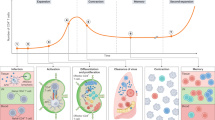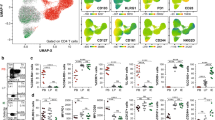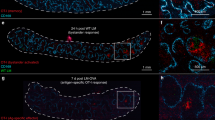Abstract
It is thought that immunity depends on naïve CD4 T cells that proliferate in response to microbial antigens1,2,3,4, differentiate into memory cells that produce anti-microbial lymphokines5,6, and migrate to sites of infection7,8. Here we use immunohistology to enumerate individual naïve CD4 T cells, specific for a model antigen, in the whole bodies of adult mice. The cells resided exclusively in secondary lymphoid tissues, such as the spleen and lymph nodes, in mice that were not exposed to antigen. After injection of antigen alone into the blood, the T cells proliferated, migrated to the lungs, liver, gut and salivary glands, and then disappeared from these organs. If antigen was injected with the microbial product lipopolysaccharide, proliferation and migration were enhanced, and two populations of memory cells survived for months: one in the lymph nodes that produced the growth factor interleukin-2, and a larger one in the non-lymphoid tissues that produced the anti-microbial lymphokine interferon-γ. These results show that antigen recognition in the context of infection generates memory cells that are specialized to proliferate in the secondary lymphoid tissues or to fight infection at the site of microbial entry.
This is a preview of subscription content, access via your institution
Access options
Subscribe to this journal
Receive 51 print issues and online access
$199.00 per year
only $3.90 per issue
Buy this article
- Purchase on Springer Link
- Instant access to full article PDF
Prices may be subject to local taxes which are calculated during checkout




Similar content being viewed by others
References
Kyburz, D. et al. T cell immunity after a viral infection versus T cell tolerance induced by soluble viral peptides. Eur. J. Immunol. 23, 1956–1962 (1993).
Kearney, E. R., Pape, K. A., Loh, D. Y. & Jenkins, M. K. Visualization of peptide-specific T cell immunity and peripheral tolerance induction in vivo. Immunity 1, 327–339 (1994).
McHeyzer-Williams, M. G. & Davis, M. M. Antigen-specific development of primary and memory T cells in vivo. Science 268, 106–111 (1995).
Murali-Krishna, K. et al. Counting antigen-specific CD8 T cells: a reevaluation of bystander activation during viral infection. Immunity 8, 177–187 (1998).
Ahmed, R. & Gray, D. Immunological memory and protective immunity: understanding their relation. Science 272, 54–60 (1996).
Dutton, R. W., Bradley, L. M. & Swain, S. L. T cell memory. Annu. Rev. Immunol. 16, 201–223 (1998).
Mackay, C. R. Homing of naive, memory and effector lymphocytes. Curr. Opin. Immunol. 5, 423–427 (1993).
Butcher, E. C. & Picker, L. J. Lymphocyte homing and homeostasis. Science 272, 60–66 (1996).
Pape, K. A. et al. Use of adoptive transfer of T-cell-antigen-receptor-transgenic T cells for the study of T-cell activation in vivo. Immunol. Rev. 156, 67–78 (1997).
Barnden, M. J., Allison, J., Heath, W. R. & Carbone, F. R. Defective TCR expression in transgenic mice constructed using cDNA-based alpha- and beta-chain genes under the control of heterologous regulatory elements. Immunol. Cell. Biol. 76, 34–40 (1998).
Dresser, D. W. Specific inhibition of antibody production. II. Paralysis induced in adult mice by small quantities of protein antigen. Nature 191, 1169–1171 (1962).
Chiller, J. M., Habicht, G. S. & Weigle, W. O. Kinetic differences in unresponsiveness of thymus and bone marrow cells. Science 171, 813–815 (1971).
Chiller, J. M. & Weigle, W. O. Termination of tolerance to human gamma globulin in mice by antigen and bacterial lipopolysaccharide (endotoxin). J. Exp. Med. 137, 740–750 (1973).
Southern, P. J., Blount, P. & Oldstone, M. B. Analysis of persistent virus infections by in situ hybridization to whole-mouse sections. Nature 312, 555–558. (1984).
Pape, K. A., Khoruts, A., Mondino, A. & Jenkins, M. K. Inflammatory cytokines enhance the in vivo clonal expansion and differentiation of antigen-activated CD4+ T cells. J. Immunol. 159, 591–598 (1997).
Murphy, K. M., Heimberger, A. B. & Loh, D. Y. Induction by antigen of intrathymic apoptosis of CD4+CD8+TCRlo thymocytes in vivo. Science 250, 1720–1723 (1990).
Pape, K. A., Merica, R., Mondino, A., Khoruts, A. & Jenkins, M. K. Direct evidence that functionally impaired CD4+ T cells persist in vivo following induction of peripheral tolerance. J. Immunol. 160, 4719–4729 (1998).
Bradley, L. M. & Watson, S. R. Lymphocyte migration into tissue: the paradigm derived from CD4 subsets. Curr. Opin. Immunol. 8, 312–320 (1996).
Alferink, J. et al. Control of neonatal tolerance to tissue antigens by peripheral T cell trafficking. Science 282, 1338–1341 (1998).
Bell, E. B. & Sparshott, S. M. Interconversion of CD45R subsets of CD4 T cells in vivo. Nature 348, 163–166 (1990).
Westermann, J. & Pabst, R. How organ-specific is the migration of ‘naı¨ve’ and ‘memory’ T cells? Immunol. Today 17, 278–282 (1996).
Vella, A. T., McCormack, J. E., Linsley, P. S., Kappler, J. W. & Marrack, P. Lipopolysaccharide interferes with the induction of peripheral T cell death. Immunity 2, 261–270 (1995).
Khoruts, A., Mondino, A., Pape, K. A., Reiner, S. L. & Jenkins, M. K. A natural immunological adjuvant enhances T cell clonal expansion through a CD28-dependent, interleukin (IL)-2-independent mechanism. J. Exp. Med. 187, 225–236 (1998).
Kim, S. K. et al. Generation of mucosal cytotoxic T cells against soluble protein by tissue-specific environmental and costimulatory signals. Proc. Natl Acad. Sci. USA 95, 10814–10819 (1998).
Kim, S. K., Schluns, K. S. & Lefrancois, L. Induction and visualization of mucosal memory CD8 T cells following systemic virus infection. J. Immunol. 163, 4125–4132 (1999).
Sallusto, F., Lenig, D., Forster, R., Lipp, M. & Lanzavecchia, A. Two subsets of memory T lymphocytes with distinct homing potentials and effector functions. Nature 401, 708–712 (1999).
Haskins, K. et al. The major histocompatibility complex-restricted antigen receptor on T cells. I. Isolation with a monoclonal antibody. J. Exp. Med. 157, 1149–1169 (1983).
Lyons, A. B. & Parish, C. R. Determination of lymphocyte division by flow cytometry. J. Immunol. Methods 171, 131–137 (1994).
Merica, R., Khoruts, A., Pape, K. A., Reinhardt, R. L. & Jenkins, M. K. Antigen-experienced CD4 T cells display a reduced capacity for clonal expansion in vivo that is imposed by factors present in the immune host. J. Immunol. 164, 4551–4557 (2000).
Acknowledgements
We thank J. Walter for technical assistance; D. Mueller, S. Jameson, M. Mescher, A. Haase, P. Southern, R. A. Reinhardt and K. Hogquist for discussions; L. Lefrancois for supplying OT-II mice; and Gerald Sedgewick for help with image analysis. Supported by grants from the NIH (M.K.J., A.K., R.M. and R.L.R.), the Cancer Research Institute (T.Z.), and the Howard Hughes Medical Institute (A.K.).
Author information
Authors and Affiliations
Corresponding author
Rights and permissions
About this article
Cite this article
Reinhardt, R., Khoruts, A., Merica, R. et al. Visualizing the generation of memory CD4 T cells in the whole body. Nature 410, 101–105 (2001). https://doi.org/10.1038/35065111
Received:
Accepted:
Issue Date:
DOI: https://doi.org/10.1038/35065111
This article is cited by
-
Unique properties of tissue-resident memory T cells in the lungs: implications for COVID-19 and other respiratory diseases
Nature Reviews Immunology (2023)
-
CD8+ tissue-resident memory T-cell development depends on infection-matching regulatory T-cell types
Nature Communications (2023)
-
CD4+ T cell memory
Nature Immunology (2023)
-
DDB1 regulates the activation-induced apoptosis of T cells via downregulating the expression of histone methyltransferase SETD7
Medical Oncology (2023)
-
Tissue resident memory T cells in the respiratory tract
Mucosal Immunology (2022)
Comments
By submitting a comment you agree to abide by our Terms and Community Guidelines. If you find something abusive or that does not comply with our terms or guidelines please flag it as inappropriate.



